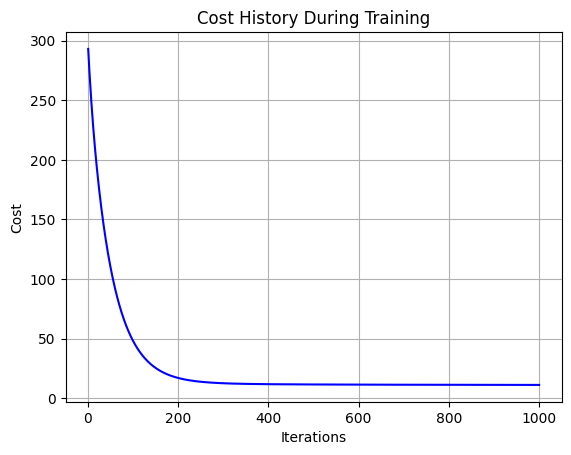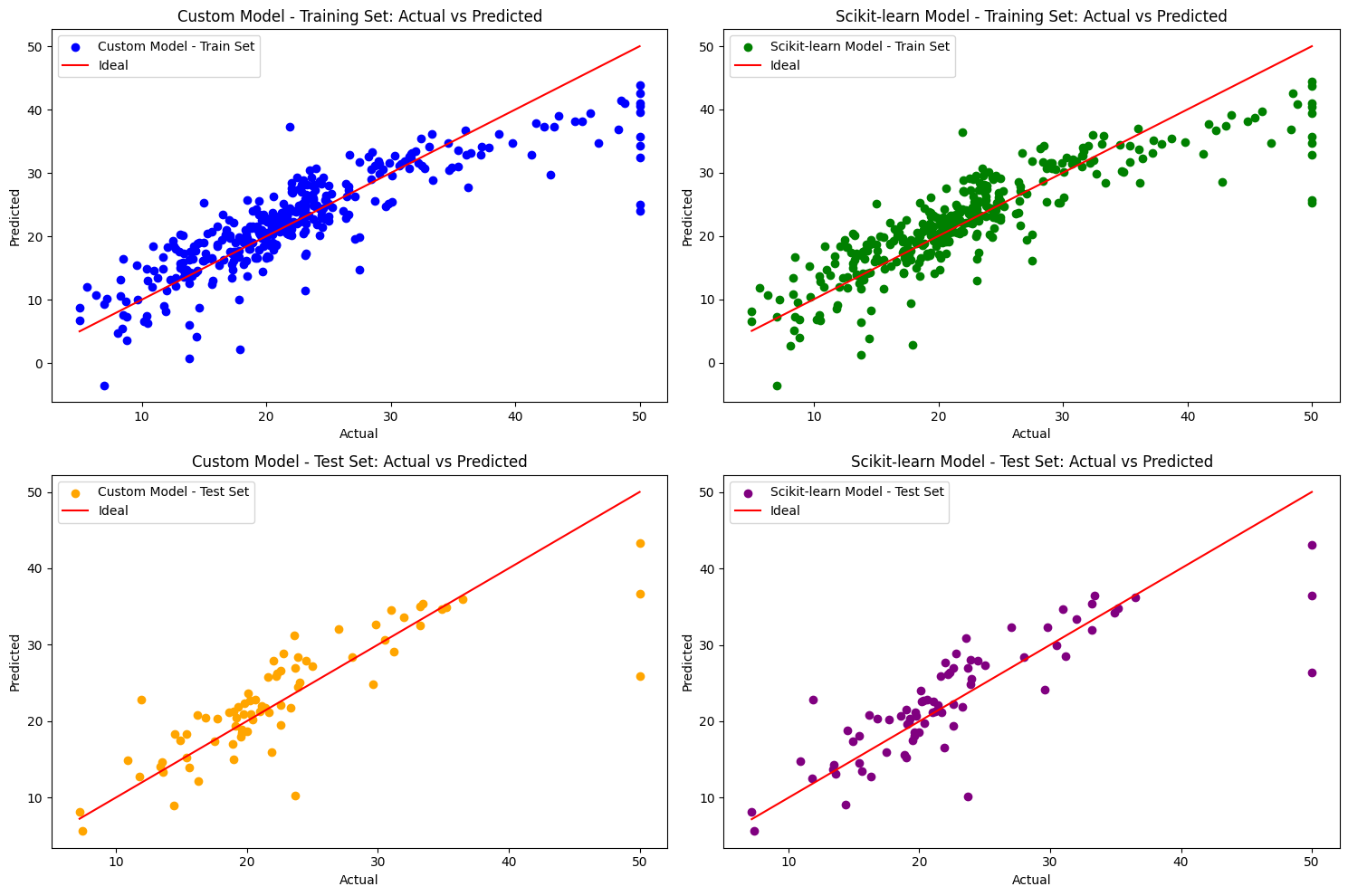Implementing Linear Regression for Predicting House Prices (From Scratch)
Implementing Linear Regression for Predicting House Prices (From Scratch)
Introduction
Bellow is my notebook from Kaggle for my project on implementing Linear Regression from scratch for Predicting House Prices and comparing it to scikit-learn predefined one.
Enjoy!
Notebook
1
2
3
4
5
6
7
8
9
10
11
12
13
14
15
16
17
# This Python 3 environment comes with many helpful analytics libraries installed
# It is defined by the kaggle/python Docker image: https://github.com/kaggle/docker-python
# For example, here's several helpful packages to load
import numpy as np # linear algebra
import pandas as pd # data processing, CSV file I/O (e.g. pd.read_csv)
# Input data files are available in the read-only "../input/" directory
# For example, running this (by clicking run or pressing Shift+Enter) will list all files under the input directory
import os
for dirname, _, filenames in os.walk('/kaggle/input'):
for filename in filenames:
print(os.path.join(dirname, filename))
# You can write up to 20GB to the current directory (/kaggle/working/) that gets preserved as output when you create a version using "Save & Run All"
# You can also write temporary files to /kaggle/temp/, but they won't be saved outside of the current session
1
/kaggle/input/the-boston-houseprice-data/boston.csv
Overview
In this notebook i will predict the house prices using linear regression. i will implement everything from scratch then compare my results to a predefined algorithm in scikit learn.
Dataset
first i will load and explore the dataset. i’m working on Boston House Prices on Kaggle
https://www.kaggle.com/datasets/fedesoriano/the-boston-houseprice-data
1
2
df = pd.read_csv("/kaggle/input/the-boston-houseprice-data/boston.csv")
df.head()
| CRIM | ZN | INDUS | CHAS | NOX | RM | AGE | DIS | RAD | TAX | PTRATIO | B | LSTAT | MEDV | |
|---|---|---|---|---|---|---|---|---|---|---|---|---|---|---|
| 0 | 0.00632 | 18.0 | 2.31 | 0 | 0.538 | 6.575 | 65.2 | 4.0900 | 1 | 296.0 | 15.3 | 396.90 | 4.98 | 24.0 |
| 1 | 0.02731 | 0.0 | 7.07 | 0 | 0.469 | 6.421 | 78.9 | 4.9671 | 2 | 242.0 | 17.8 | 396.90 | 9.14 | 21.6 |
| 2 | 0.02729 | 0.0 | 7.07 | 0 | 0.469 | 7.185 | 61.1 | 4.9671 | 2 | 242.0 | 17.8 | 392.83 | 4.03 | 34.7 |
| 3 | 0.03237 | 0.0 | 2.18 | 0 | 0.458 | 6.998 | 45.8 | 6.0622 | 3 | 222.0 | 18.7 | 394.63 | 2.94 | 33.4 |
| 4 | 0.06905 | 0.0 | 2.18 | 0 | 0.458 | 7.147 | 54.2 | 6.0622 | 3 | 222.0 | 18.7 | 396.90 | 5.33 | 36.2 |
1
df.shape
1
(506, 14)
1
df.info()
1
2
3
4
5
6
7
8
9
10
11
12
13
14
15
16
17
18
19
20
21
<class 'pandas.core.frame.DataFrame'>
RangeIndex: 506 entries, 0 to 505
Data columns (total 14 columns):
# Column Non-Null Count Dtype
--- ------ -------------- -----
0 CRIM 506 non-null float64
1 ZN 506 non-null float64
2 INDUS 506 non-null float64
3 CHAS 506 non-null int64
4 NOX 506 non-null float64
5 RM 506 non-null float64
6 AGE 506 non-null float64
7 DIS 506 non-null float64
8 RAD 506 non-null int64
9 TAX 506 non-null float64
10 PTRATIO 506 non-null float64
11 B 506 non-null float64
12 LSTAT 506 non-null float64
13 MEDV 506 non-null float64
dtypes: float64(12), int64(2)
memory usage: 55.5 KB
1
df.describe()
| CRIM | ZN | INDUS | CHAS | NOX | RM | AGE | DIS | RAD | TAX | PTRATIO | B | LSTAT | MEDV | |
|---|---|---|---|---|---|---|---|---|---|---|---|---|---|---|
| count | 506.000000 | 506.000000 | 506.000000 | 506.000000 | 506.000000 | 506.000000 | 506.000000 | 506.000000 | 506.000000 | 506.000000 | 506.000000 | 506.000000 | 506.000000 | 506.000000 |
| mean | 3.613524 | 11.363636 | 11.136779 | 0.069170 | 0.554695 | 6.284634 | 68.574901 | 3.795043 | 9.549407 | 408.237154 | 18.455534 | 356.674032 | 12.653063 | 22.532806 |
| std | 8.601545 | 23.322453 | 6.860353 | 0.253994 | 0.115878 | 0.702617 | 28.148861 | 2.105710 | 8.707259 | 168.537116 | 2.164946 | 91.294864 | 7.141062 | 9.197104 |
| min | 0.006320 | 0.000000 | 0.460000 | 0.000000 | 0.385000 | 3.561000 | 2.900000 | 1.129600 | 1.000000 | 187.000000 | 12.600000 | 0.320000 | 1.730000 | 5.000000 |
| 25% | 0.082045 | 0.000000 | 5.190000 | 0.000000 | 0.449000 | 5.885500 | 45.025000 | 2.100175 | 4.000000 | 279.000000 | 17.400000 | 375.377500 | 6.950000 | 17.025000 |
| 50% | 0.256510 | 0.000000 | 9.690000 | 0.000000 | 0.538000 | 6.208500 | 77.500000 | 3.207450 | 5.000000 | 330.000000 | 19.050000 | 391.440000 | 11.360000 | 21.200000 |
| 75% | 3.677083 | 12.500000 | 18.100000 | 0.000000 | 0.624000 | 6.623500 | 94.075000 | 5.188425 | 24.000000 | 666.000000 | 20.200000 | 396.225000 | 16.955000 | 25.000000 |
| max | 88.976200 | 100.000000 | 27.740000 | 1.000000 | 0.871000 | 8.780000 | 100.000000 | 12.126500 | 24.000000 | 711.000000 | 22.000000 | 396.900000 | 37.970000 | 50.000000 |
1
2
# Shuffle the data
data = df.sample(frac=1, random_state=42).reset_index(drop=True)
1
2
3
4
5
6
7
8
# Calculate the number of samples for each set
train_size = int(0.7 * len(data))
val_size = int(0.15 * len(data))
# Split the dataset into training, validation, and test sets
train_data = data[:train_size] # training data (70%)
val_data = data[train_size:train_size+val_size] # validation data (15%)
test_data = data[train_size+val_size:] # test data (15%)
1
2
3
4
5
6
7
8
9
# Split the features and target for each set
X_train = train_data.drop('MEDV', axis=1)
y_train = train_data['MEDV']
X_val = val_data.drop('MEDV', axis=1)
y_val = val_data['MEDV']
X_test = test_data.drop('MEDV', axis=1)
y_test = test_data['MEDV']
1
2
3
print(f"Training set size: {len(X_train)} samples")
print(f"Validation set size: {len(X_val)} samples")
print(f"Test set size: {len(X_test)} samples")
1
2
3
Training set size: 354 samples
Validation set size: 75 samples
Test set size: 77 samples
Model
Linear Regression from scratch
1
2
3
4
5
6
7
8
9
10
11
12
13
14
15
16
17
18
19
20
21
22
23
24
25
26
27
28
29
30
31
32
33
34
35
36
37
38
39
40
41
42
43
44
45
46
47
48
49
50
51
52
53
class LinearRegression:
def __init__(self, alpha=0.01, iterations=1000, scale=False):
self.alpha = alpha # Learning rate
self.iterations = iterations # Number of iterations for gradient descent
self.scale = scale # Whether to scale the features or not
self.w = None # Weights
self.b = None # Bias
self.cost_history = [] # List to track cost history
def scale_features(self, X):
"""Scale features using mean and std deviation (standardization)."""
self.mean = np.mean(X, axis=0)
self.std = np.std(X, axis=0)
return (X - self.mean) / self.std
def fit(self, X, y):
"""Fit the model to the training data using gradient descent."""
m = len(y) # Number of training examples
# If scaling is needed, scale the features
if self.scale:
X = self.scale_features(X)
# Initialize weights (w) and bias (b)
self.w = np.zeros(X.shape[1])
self.b = 0
# Perform gradient descent
for i in range(self.iterations):
predictions = X.dot(self.w) + self.b
error = predictions - y
# Gradient of the cost function with respect to w and b
dw = (1/m) * np.dot(X.T, error)
db = (1/m) * np.sum(error)
# Update weights and bias
self.w -= self.alpha * dw
self.b -= self.alpha * db
# Calculate the cost (Mean Squared Error)
cost = (1/(2*m)) * np.sum(error ** 2)
self.cost_history.append(cost)
def predict(self, X):
"""Make predictions using the trained model."""
# If scaling was applied, scale the new data as well
if self.scale:
X = (X - self.mean) / self.std
return X.dot(self.w) + self.b
def get_cost_history(self):
return self.cost_history
1
2
3
4
5
6
7
8
9
10
11
12
13
14
15
16
17
18
19
20
21
22
23
24
25
26
27
28
29
30
31
32
import matplotlib.pyplot as plt
def mean_squared_error(y_true, y_pred):
m = len(y_true)
return (1/m) * np.sum((y_true - y_pred) ** 2)
# Initialize and train the model
model = LinearRegression(alpha=0.01, iterations=1000, scale=True)
model.fit(X_train, y_train)
cost_history = model.get_cost_history()
plt.plot(range(1, len(cost_history) + 1), cost_history, color='blue')
plt.title('Cost History During Training')
plt.xlabel('Iterations')
plt.ylabel('Cost')
plt.grid(True)
plt.show()
# Make predictions on all datasets
y_train_pred = model.predict(X_train)
y_val_pred = model.predict(X_val)
y_test_pred = model.predict(X_test)
# Calculate Mean Squared Error for all datasets
train_mse = mean_squared_error(y_train, y_train_pred)
val_mse = mean_squared_error(y_val, y_val_pred)
test_mse = mean_squared_error(y_test, y_test_pred)
print(f"Training MSE: {train_mse}")
print(f"Validation MSE: {val_mse}")
print(f"Test MSE: {test_mse}")
1
2
3
Training MSE: 22.384617927405444
Validation MSE: 21.208792092413585
Test MSE: 22.102794782467647
1
2
3
4
5
6
7
8
9
10
11
12
13
14
15
16
17
18
19
20
21
22
23
24
25
26
27
28
29
30
31
32
# Plot the actual vs predicted values for all datasets
plt.figure(figsize=(15, 5))
# Training data plot
plt.subplot(1, 3, 1)
plt.scatter(y_train, y_train_pred, color='blue', label="Train Set")
plt.plot([min(y_train), max(y_train)], [min(y_train), max(y_train)], color='red', label="Ideal")
plt.title('Training Set: Actual vs Predicted')
plt.xlabel('Actual')
plt.ylabel('Predicted')
plt.legend()
# Validation data plot
plt.subplot(1, 3, 2)
plt.scatter(y_val, y_val_pred, color='green', label="Validation Set")
plt.plot([min(y_val), max(y_val)], [min(y_val), max(y_val)], color='red', label="Ideal")
plt.title('Validation Set: Actual vs Predicted')
plt.xlabel('Actual')
plt.ylabel('Predicted')
plt.legend()
# Test data plot
plt.subplot(1, 3, 3)
plt.scatter(y_test, y_test_pred, color='orange', label="Test Set")
plt.plot([min(y_test), max(y_test)], [min(y_test), max(y_test)], color='red', label="Ideal")
plt.title('Test Set: Actual vs Predicted')
plt.xlabel('Actual')
plt.ylabel('Predicted')
plt.legend()
plt.tight_layout()
plt.show()
Linear Regression using scikit-learn and comparison
1
2
3
4
5
6
7
8
9
10
11
12
13
14
15
16
17
18
19
20
21
22
23
24
25
26
27
28
29
30
31
32
33
34
35
36
37
38
39
40
41
42
43
44
45
46
47
48
49
50
51
52
53
54
55
56
57
58
59
60
61
62
63
64
65
66
67
68
69
70
71
from sklearn.linear_model import LinearRegression as SklearnLR
from sklearn.metrics import mean_squared_error
# Scikit-learn Linear Regression Model
sklearn_model = SklearnLR()
sklearn_model.fit(X_train, y_train)
y_train_pred_sklearn = sklearn_model.predict(X_train)
y_val_pred_sklearn = sklearn_model.predict(X_val)
y_test_pred_sklearn = sklearn_model.predict(X_test)
# Calculate Mean Squared Error for both models
train_mse = mean_squared_error(y_train, y_train_pred)
val_mse = mean_squared_error(y_val, y_val_pred)
test_mse = mean_squared_error(y_test, y_test_pred)
train_mse_sklearn = mean_squared_error(y_train, y_train_pred_sklearn)
val_mse_sklearn = mean_squared_error(y_val, y_val_pred_sklearn)
test_mse_sklearn = mean_squared_error(y_test, y_test_pred_sklearn)
print("Custom Model MSE:")
print(f"Training MSE: {train_mse}")
print(f"Validation MSE: {val_mse}")
print(f"Test MSE: {test_mse}")
print("\nScikit-learn Model MSE:")
print(f"Training MSE: {train_mse_sklearn}")
print(f"Validation MSE: {val_mse_sklearn}")
print(f"Test MSE: {test_mse_sklearn}")
# Plot the actual vs predicted values for both models
plt.figure(figsize=(15, 10))
# Custom Model - Training Data
plt.subplot(2, 2, 1)
plt.scatter(y_train, y_train_pred, color='blue', label="Custom Model - Train Set")
plt.plot([min(y_train), max(y_train)], [min(y_train), max(y_train)], color='red', label="Ideal")
plt.title('Custom Model - Training Set: Actual vs Predicted')
plt.xlabel('Actual')
plt.ylabel('Predicted')
plt.legend()
# Scikit-learn Model - Training Data
plt.subplot(2, 2, 2)
plt.scatter(y_train, y_train_pred_sklearn, color='green', label="Scikit-learn Model - Train Set")
plt.plot([min(y_train), max(y_train)], [min(y_train), max(y_train)], color='red', label="Ideal")
plt.title('Scikit-learn Model - Training Set: Actual vs Predicted')
plt.xlabel('Actual')
plt.ylabel('Predicted')
plt.legend()
# Custom Model - Test Data
plt.subplot(2, 2, 3)
plt.scatter(y_test, y_test_pred, color='orange', label="Custom Model - Test Set")
plt.plot([min(y_test), max(y_test)], [min(y_test), max(y_test)], color='red', label="Ideal")
plt.title('Custom Model - Test Set: Actual vs Predicted')
plt.xlabel('Actual')
plt.ylabel('Predicted')
plt.legend()
# Scikit-learn Model - Test Data
plt.subplot(2, 2, 4)
plt.scatter(y_test, y_test_pred_sklearn, color='purple', label="Scikit-learn Model - Test Set")
plt.plot([min(y_test), max(y_test)], [min(y_test), max(y_test)], color='red', label="Ideal")
plt.title('Scikit-learn Model - Test Set: Actual vs Predicted')
plt.xlabel('Actual')
plt.ylabel('Predicted')
plt.legend()
plt.tight_layout()
plt.show()
1
2
3
4
5
6
7
8
9
Custom Model MSE:
Training MSE: 22.384617927405444
Validation MSE: 21.208792092413585
Test MSE: 22.102794782467647
Scikit-learn Model MSE:
Training MSE: 22.018971306970627
Validation MSE: 22.53291330113675
Test MSE: 22.14619818293375
This post is licensed under CC BY 4.0 by the author.


